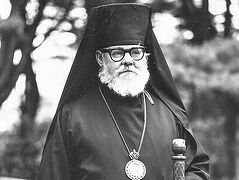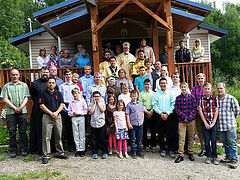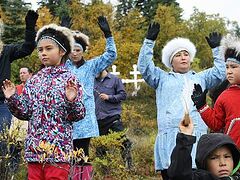See part 1
Archbishop Gregory of Alaska and Sitka wasn’t one of the “high-profile” archpastors of the Russian exile community. Peaceful, simple-hearted, hardworking, and selfless man of faith, he was one of those who kept Russia and the Russian Church strong since time immemorial.
“He would readily give his neighbor the shirt off his back”
Dr. Konstantin Kallaur, Professor Emeritus, Department of Foreign Languages at the Nassau Community College, Garden City, NY:
—My family met future Bishop Gregory, then a young man, two years after he arrived in the United States from Germany. I think it was around 1950. At the time, we resided in Waterbury, Connecticut, about ninety miles from New York City. Vladyka descended from a priestly family and had a natural tendency to make friends with and stay around clergy. My father, a priest in the Orthodox Church of America (known as the Metropolia at the time), was in the process of getting assigned to a parish. The young man served as choir director in a local Orthodox church. The choir members loved him for his simplicity and sense of humor. Before the church in Waterbury, he conducted a choir at one of the Orthodox churches in New Jersey, can’t recall where exactly. At one point, he also worked as an interpreter at the Ministry of Defense. So, he adapted well to the new lifestyle and assimilated quite successfully here.
He would often visit us at our home. He was always polite, attentive, and sociable. He shared how the Church as a whole and his family in particular had suffered under communism. His grandfather and father were priests. His grandfather was arrested by the KGB and died while in jail, whereas his father spent a few years behind bars. His mother became a spiritual anchor for many Kievans at the time. Many people would bring her icons and other religious objects for safekeeping. He also told us how the KGB agents once came to his mother, and one of them asked her: “Do you believe in God?” She pointed at the wall filled with icons and replied: “What do you think?” The rest of the visit passed in deadly silence. The whole family was repressed. In summer Vladyka slept on the floor, and in winter on the table to stay warm … Everyone was undernourished.
On another occasion, Vladyka could entertain us by telling all kinds of funny stories that happened to him or his uncle after they arrived in the U.S. from different places and at varying times. For example, his uncle insisted that the “Welcome to New York!” sign he saw on buses was addressed to him personally. Interestingly, his uncle Nikolai Afonsky was a prominent choir director at the New York Cathedral of the Protection of the Holy Virgin of the Orthodox Church of America.
Over time our paths separated, although we never lost sight of each other. He studied at the University of Connecticut, and soon after graduation he entered the St. Vladimir’s Seminary, graduating in 1965. He paid particular attention to Canon Law, and I think the professor at the seminary was grooming him as his replacement. A few years later, he was awarded a second degree, Master of Theology (1970), at Saint Vladimir Seminary. Our paths crossed again when Georgiy studied to obtain a Master of Arts Degree at the Hofstra University (1970) while I taught there. He was so thirsty for new knowledge that he received two Masters degrees! He never quit learning and continued writing throughout his life.
During the 1960s, when my parents lived in Stamford, he used to visit them frequently; and later, when my mother was hospitalized with cancer, he often went to see her at the hospital. He was at her bedside when she passed away (interestingly, my son-in-law, a physician, stayed with Vladyka at his Staten Island residence at the time of his first heart attack). I mentioned it to point out Archbishop Gregory’s charity, kindness, helpfulness, and generosity. He could give the shirt off his back to a neighbor in need.
He loved the Alaskans and they loved him back. He reorganized and consolidated the position of the St. Herman Theological Seminary and re-energized life in the diocese. He shared unbelievable stories of how he tried to get by plane, boat, or sleds to the far-flung corners of his diocese and visit the parishioners who hadn’t seen a priest for decades, and had never seen a bishop.
When he visited the lower forty-eight states, he frequently stayed with us. Once, he brought the miracle-working Sitka Icon of the Mother of God with him. It was a great honor for our family! My wife and I felt terribly sorry that we hadn’t responded to Vladyka’s invitation to visit him in Alaska. Our friendship was a blessing to my parents, brothers, and later my own family.
A staunch supporter of Orthodoxy
Dr. Jeffrey McDonald, Ph.D. in Theology (Resurrection Theological Academy in Shen Vlash (Albania):
Bishop Gregory did very much to strengthen the position of the Orthodox Church in Alaska. He frequently traveled around the state and visited every Orthodox village, including the most remote ones. Every year, he organized missionary trips to the villages located along the major Alaskan rivers (it seems like the author is speaking about the Yukon and Koyuk Rivers as well as the Kuskokvim River with tributaries.—A.N.) where he fielded questions from the locals. Following in the footsteps of Holy Hierarch Innocent, Metropolitan of Moscow, and Sts. Cyril and Methodius, he wanted to see the people worship God in their native language and supported the idea of using native languages and English in worship, with the addition of certain hymns in Old Slavonic.
He spent a greater part of the year teaching the History of the Church in Alaska, the Orthodox Dogmatic Theology and Canon Law at the St. Herman Theological Seminary in Kodiak, where he was loved by both the students and the local faithful. Based on his earlier work at the archives, he penned two books on the history of the Church in North America as well as a theological essay, “Christ and the Church.” He spent a part of the year in Sitka, serving at the Cathedral.
 Teachers and students at the St. Herman Seminary. Early 1990s.
Teachers and students at the St. Herman Seminary. Early 1990s.
The bishop was a kind-hearted man of genuine faith. He unflinchingly supported the autocephaly of the Orthodox Church in America as the canonical foundation of a future Orthodox unity in the USA, seeing in it the continuation of true Orthodox mission. As a member of the Holy Synod of Bishops of the Orthodox Church of America, he opposed the Balamand Agreement of 1993 and in this respect, he asserted influence over the rest of the Synod. He was also very concerned about the participation of the Church in the National Council of Churches, and when an OCA priest presided there, he urged him to abandon his seat. The archbishop perceived himself and was recognized by many members of the Church in the USA as a staunch upholder of Orthodox teaching.
God is the God of love more than a righteous Judge
Very Rev. John Breck, theologian, Professor of Biblical Exegesis and Patristics at the St. Sergius Orthodox Theological Institute in Paris, Director of St. Silouan Retreat Center on Wadmalaw Island, South Carolina:
I met Vladyka in February of 1975 when I taught for five weeks at the newly reopened St. Herman Theological Seminary in Kodiak. For the most part, I instructed the indigenous Yupiaq students on the foundations of the Orthodox faith, as well as Holy Scripture and Eucharistic Theology. I had such a positive experience with them that I returned to France and convinced my family to move to Kodiak for two years with me so that I could continue teaching there. Two years turned to three, because, in February 1977, Bishop Gregory ordained me a priest. I was assigned to serve as a school chaplain and awarded the title of Professor of New Testament.
Bishop Gregory manifested sincere love and respect for the local students. He was touched by their simplicity and deep spirituality. Some of them were ordained and still serve in parishes in Alaska.
Every Thursday evening, whenever the bishop was in town, we would meet with the parishioners of the Holy Resurrection Cathedral in Kodiak to serve an akathist to St. Herman, whose relics were held in a carved wooden reliquary at the church nave. Bishop Gregory would mount his glasses on top of his head, squint at the text of the akathist and go on to direct a local choir that sounded rather inconsistent and out of tune. These evenings were truly unforgettable, made even more memorable thanks to the presence of beloved Vladyka!
 The Holy Resurrection Cathedral in Kodiak
The Holy Resurrection Cathedral in Kodiak
Here I will offer a few examples to illustrate Bishop Gregory’s approach to the issues of pastoral care. When my family and I returned to Kodiak in the summer of 1975, the local church warden’s wife committed suicide. She was a faithful and well-known member of the local community who had dedicated her life to serving others. One day, she discovered that her husband was unfaithful to her, a crime he committed more than once in the past. The woman couldn’t make peace with his unacceptable behavior anymore and, deeply depressed, took her own life. The parishioners were devastated, thinking she would never receive a church burial. It took the bishop a few days to consider his next step. Finally, he announced that the woman was mentally deranged and crushed by sorrow, which in my opinion was the correct diagnosis. Although some cried foul, Bishop Gregory served a traditional funeral service—a decision accepted in the end by practically everyone in the community.
 The local clergy Another time, in the dead of winter, the bishop and I traveled to a remote village to meet with people who never had a bishop visit them before. It was the eve of the Veneration of the Cross, which marked the halfway point of the Forty Day Fast. We told them about the upcoming visit and asked them to refrain from making any fancy arrangements for us. Bishop Gregory wanted to have it done without any fuss at all. He arranged that we are served a simple Lenten meal following our arrival prior to evening service.
The local clergy Another time, in the dead of winter, the bishop and I traveled to a remote village to meet with people who never had a bishop visit them before. It was the eve of the Veneration of the Cross, which marked the halfway point of the Forty Day Fast. We told them about the upcoming visit and asked them to refrain from making any fancy arrangements for us. Bishop Gregory wanted to have it done without any fuss at all. He arranged that we are served a simple Lenten meal following our arrival prior to evening service.
We reached the village sometime before noon. Most of its male inhabitants were away fishing or hunting. When we emerged from our snow-and-ice-covered snowmobile, we were greeted by a crowd of women and children. We thawed out and then the women from the local church community invited us to have lunch. Vladyka said a prayer before the meal and two women disappeared into the kitchen. In the meantime, the bishop said a few words about the upcoming feast of the Honorable Cross and explained its meaning as the commemoration of the midpoint of the Forty Day Fast. He also mentioned the importance of fasting.
 New Jersey, 1996 Then, two women returned from the kitchen carrying large serving trays. I removed the lids and we peeked inside. One had a piece of beef, fried deer meat in another, a third one had veggies in a butter sauce, and the fourth tray had something unrecognizable that turned out to be a porcupine. I looked at Vladyka and whispered: “What should we do?” He looked back at me and said with his heavily accented “Russian” English: “FaDDAr John, eat what is in front of you!” That’s what we did. Everyone present greatly enjoyed our common meal. Afterward, Bishop Gregory cautiously asked one of the women if they observe Great Lent here. “Of course, your Grace!” she replied. “When?” he asked. Here is what she answered: “We begin it on our son’s birthday. This year, it will be next Tuesday!” Vladyka smiled in reply. He later whispered: “We aren’t in Russia any longer!”
New Jersey, 1996 Then, two women returned from the kitchen carrying large serving trays. I removed the lids and we peeked inside. One had a piece of beef, fried deer meat in another, a third one had veggies in a butter sauce, and the fourth tray had something unrecognizable that turned out to be a porcupine. I looked at Vladyka and whispered: “What should we do?” He looked back at me and said with his heavily accented “Russian” English: “FaDDAr John, eat what is in front of you!” That’s what we did. Everyone present greatly enjoyed our common meal. Afterward, Bishop Gregory cautiously asked one of the women if they observe Great Lent here. “Of course, your Grace!” she replied. “When?” he asked. Here is what she answered: “We begin it on our son’s birthday. This year, it will be next Tuesday!” Vladyka smiled in reply. He later whispered: “We aren’t in Russia any longer!”
There are endless stories like these that I could share with you. They shed light on the pastoral empathy that characterized Vladyka and his ministry. He was quite strict about fasting, church etiquette, etc. But he always prioritized people’s feelings and spiritual needs over what could be considered “ecclesiastically correct.”
He always took care to adhere to the canons and traditions of the Church. But he understood that God is God of love more than a righteous Judge. Thus, he was driven by the desire to share this with his flock and the seminarians.
The Archbishop was often ignored and undervalued by other members of the Church, who neither got to know him closer nor appreciated his devotion to the Body of Christ. For me it was a great honor to be ordained by him, and I hope that one day, by God’s mercy, I will meet him again.
Faithful until the very end
Lynn Breck, Very Rev. John Breck’s wife:
Vladyka could tell the clergy to serve the Liturgy while he climbed upstairs to a choir balcony to conduct the choir
I met Bishop Gregory for the first time when, in the 1970s, my husband and I moved to Kodiak Island in Alaska to work at the St. Herman Theological Seminary. He was a kind, candid, and simple man. He was instrumental in the development of the St. Herman Pastoral School founded by Archpriest Joseph Kreta in Kenai in 1975 for the indigenous Alaskans. The official status of the school was improved, it became a seminary, and was later transferred to Kodiak Island.
Archimandrite Gregory was elevated to the rank of a bishop at the St. Michael Cathedral in Sitka in the presence of Metropolitan Iriney, Archbishop Cyprian, and Bishop Theodosius (Lazor). Vladyka has become the first bishop ever elevated to this rank in Alaska and for the people of Alaska.
Vladyka was a musician and he could leave the clergy downstairs to serve the liturgy while he climbed upstairs to the choir balcony to conduct the choir. He used to call the sopranos the “angels.” Since Kodiak was built on a seismic fault line, during occasional earthquakes the choir had to deal with a wobbly floor underneath their feet. An unforgettable experience that required some courage!
Once, in the dead of winter, Bishop Gregory decided to take a walk downtown to make a “special purchase.” My husband accompanied him. Holding on to each other tightly, they went sliding and rolling down the icy hillside. My husband hadn’t yet been ordained at the time and Vladyka addressed him as “Doctor”, since he had already finished his doctoral studies in Heidelberg. When the two of them had already rolled down to the bottom of the hill, the wind pulled up the bishop’s ryassa, and, losing his balance, he grabbed my husband’s hand, crying out, “Doctor, hold onto me!” Eventually, when they had finally reached the downtown area, they were both barely able to stand. There they found a jewelry store where Bishop Gregory selected a small silver pin with a “black diamond” mounted on top as a gift for me. For some reason, he wanted to make this gift. I was deeply touched and thankful to him.
As he advanced in years, Bishop Gregory retired in New Jersey. That is my native state. One day, when I was visiting my parents, I went to see Vladyka. He had a tiny white rabbit that was always beside him. Even in retirement, he embraced life at its fullest, as straightforward and caring as before.
I am thankful to God that He let me get acquainted with Vladyka. I always think of Bishop Gregory as a warrior for Christ who walked the way of holiness, seeking God’s will and staying faithful till the very end. No matter what he did, whether he was in the kitchen cooking a pot full of borscht or serving Liturgy, he wholly and fully dedicated himself to the task of staying true to his vital personality inspired by God.
The author expresses gratitude to Alexey Liberovsky, the OCA Registrar, for providing the archival OCA documents and photos used in the article, and to Jeffrey McDonald for the photos and articles from his personal files.






